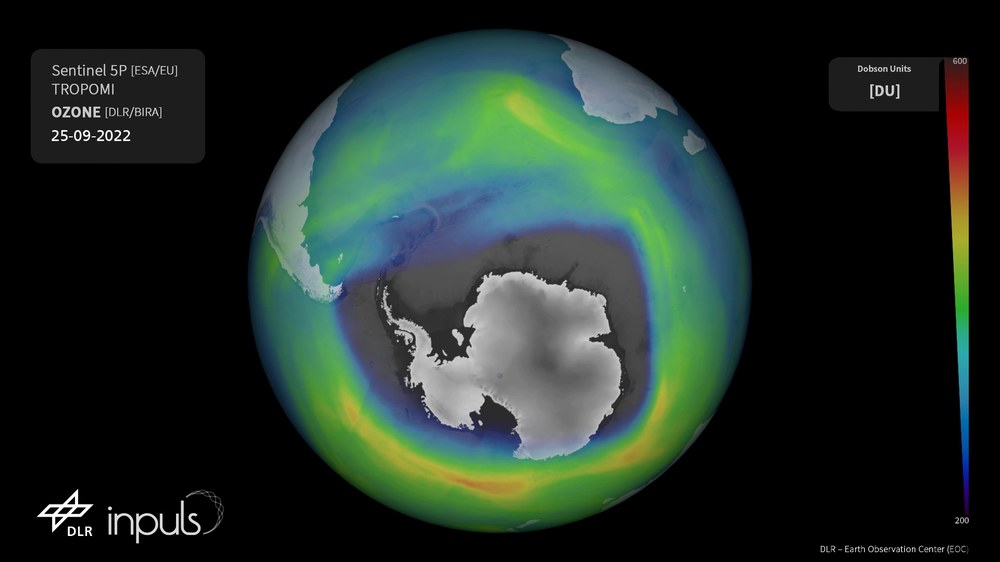What’s the latest on ozone? – International Ozone Layer Protection Day –
September 16 is Ozone Layer Protection Day. In 1987 on this day in Montreal the representatives of 46 states signed an agreement that prohibited the use of chlorofluorocarbons (CFC). These compounds had already seriously damaged Earth’s ozone layer. What has happened since then to the ozone layer, 35 years after this agreement went into effect?
With the help of satellite measurements scientists discovered a huge hole in the ozone layer in 1985. Point measurements from balloon releases had already documented the loss of ozone earlier, but were often ignored. After discovering the extent of the problem it was soon evident that neither volcanic eruptions nor natural ozone layer dynamics were responsible for the phenomenon. It was possible to attribute the decrease to chemical compounds (primarily CFCs) that were in large-scale use since the 1930’s in industry and households, for example in refrigerators.
Ozone reduction occurs every year in Antarctic springtime when especially low temperatures dominate after polar winter and at the same time enough energy to drive the decomposition reactions is provided by the returning sun. If the amount of ozone measured by the satellites drops below a certain limit (under 220 Dobson units), one speaks of an ozone hole. The ozone season usually begins in mid-August—and sometimes individual smaller holes can be seen before that date, as was the case this year from July 15-18 over the South Atlantic and the Antarctic Ocean. Measurements from Europe’s Sentinel-5P (S5p) satellite show correspondingly low ozone values there. Over the pole itself measurements with S5p are only possible after September 21 because of polar night. Thereafter, the ozone hole can be monitored until December before the polar vortex weakens, usually around early to-mid December. As a result temperatures rise over the pole and air that is richer in ozone streams in from the surroundings so that ozone values rise again. Unusual meteorological conditions can, however, preserve the ozone hole longer, as for example in 2020, when it collapsed only on December 26.
The size of the ozone hole can already be estimated with S5p measurements. Its area is currently about 20 million square kilometres. However, its true size is apt to be underestimated since, as mentioned above, there are as yet no measurements over the pole itself. Compared with recent years this size is not unusual. What size it will finally reach and how thin the ozone layer will then be cannot yet be predicted. The size of the ozone hole varies from year to yar since ozone depletion and concentration are influenced by the temperature and by dynamic flow conditions in the upper atmosphere. The good news is that the concentration of CFCs has gradually diminished over the past 20 years and the ozone layer is recovering. Since CFCs are known for their longevity, their prohibition can show its effect only after a delay, and complete recovery of the ozone hole could take up to 100 years. The bad news is that because of climate change the troposphere (up to about 10-18 km altitude) will become warmer and the stratosphere (up to about 60 km higher) cooler – which slows down the recovery.

What’s the latest on ozone?
Your consent to the storage of data ('cookies') is required for the playback of this video on Quickchannel.com. You can view and change your current data storage settings at any time under privacy.
Monitoring
Only satellites make it possible to monitor the ozone layer globally, comprehensively and continuously. Measurements from the TROPOMI instrument on the Copernicus satellite Sentinel-5 Precursor (S5p) continue extending the long time series of European measurements that began already in 1995 with GOME (Global Ozone Monitoring Experiment) on ERS2. The series was first lengthened with SCIAMACHY on Envisat, then with OMI on AURA and the GOME-2 instruments on METOP satellites.
At DLR data from the TROPOMI instrument, which is part of the ESA/EU S5p project, is being assessed, and data from the GOME-2 instrument is being analysed for the EUMETSAT ACSAF project.
All these measurements are also used by DLR to generate a consistent time series for the ESA CCI+ project and the ECMWF C3S project. This makes it possible to better monitor the long-term evolution of the ozone layer.
